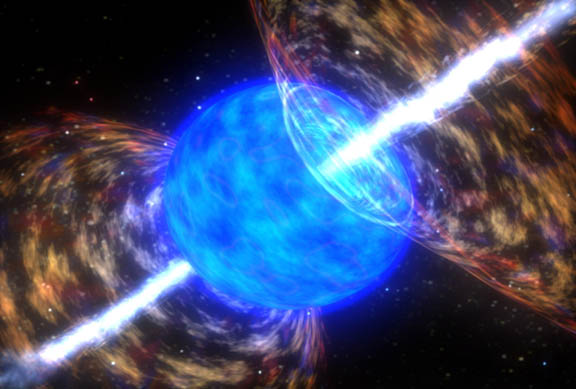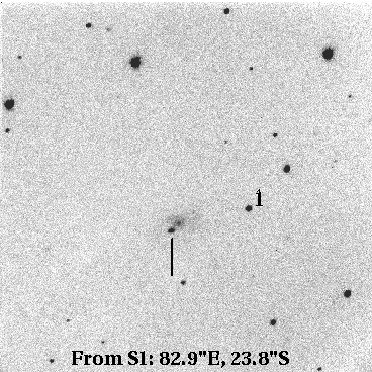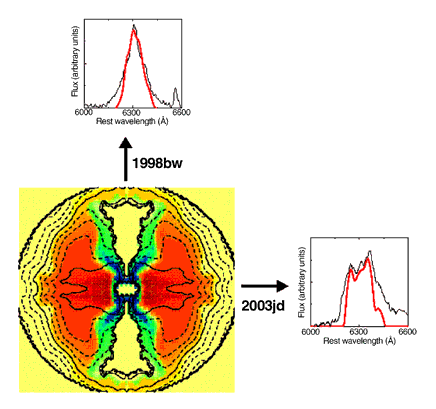An explosive character prone to sudden outbursts has been watched with two of the world’s largest telescopes. The evidence points to a peculiar kind of star as being behind the elusive gamma-ray bursts (GRBs) that have puzzled observers for more than thirty years.
An international team of astronomers from Japan, Italy, Germany, the US and China, Germany, Italy, Japan, and the United States made observations of so-called naked carbon/oxygen stars with the Keck and Subaru telescopes in Hawaii. These stars flatten as they collapse into a black hole and have been considered good candidates for the source of gamma-ray bursts. The new observations, though not a smoking gun, provide a major piece of evidence that the theory, called the collapsar model, is correct. The model explains how an asymmetric exploding star produces a tight beam of matter and energy from each pole that generates an intense burst of gamma rays, while the absence of a hydrogen and helium envelope allows the blast to escape.

Gamma ray burst (Credit: NASA)
Gamma-ray bursts are brief but intense flashes of X-rays and gamma rays that are observed randomly in the sky approximately once a day, briefly outshining the sun a million trillion times. It was not until 1997, however, that astronomers demonstrated that the sources are outside the Milky Way Galaxy, and only recently have they begun to piece together evidence to show that gamma ray bursts are associated with supernovae.
Astronomers suggest that as a certain kind of star collapses it produces two highly collimated jets of particles and energy that flash outward from the poles, rather like the light from a lighthouse. The jets produce a shock wave when they hit gas and dust around the star, which in turn accelerates particles to energies at which they emit gamma rays and X-rays. The initial burst fades within a few seconds, but afterglow shockwaves are visible to optical, radio and X-ray telescopes for several days, and distortion of the spectrum of the light reaching Earth lasts for years.

Supernova
One suspect for the type of supernova that could produce gamma-ray bursts is the Type Ic supernova, and in particular a highly energetic and bright subgroup of these, called hypernovae. Type Ic supernovae result from massive stars whose winds have shed their outer envelopes of hydrogen and often all their helium, or that have lost these outer layers to a binary companion. Only their cores of carbon and oxygen, with an inner core of iron remain, hence the naked of their colloquial name.

Aspherical explosion of a massive star and direction dependent shape of the oxygen line. For Supernova 1998bw, the gamma-ray burst and jet were directed towards the Earth. The oxygen line in the supernova spectrum had one sharp maximum (red: model, black: observation). For SN 2003jd the observer was positioned at a large angle relative to the jet axis and the oxygen line had two maxima. (Mazzali et al)
Though astronomers have observed a couple of bursts associated with this type of supernova, the theory of how a hypernova produces gamma rays is still speculative. It appears that to produce a gamma-ray burst, a core-collapse supernova needs to be both asymmetric in its explosion mechanism, so that there is a natural axis along which matter can more easily squirt, and free of a hydrogen envelope, so that the jet doesn’t have to pummel through a lot of material, explains team member Alex Filippenko, of the University of California Berkeley.
Team leader Paolo Mazzali of the Trieste Observatory in Italy and the Max-Planck Institute for Astrophysics in Garching, Germany, explains that about two years ago, the UC Berkeley researchers discovered a Type Ic supernova using Filippenko’s automated supernova search telescope, the Katzman Automatic Imaging Telescope (KAIT) at the University of California’s Lick Observatory. Called SN 2003jd, the supernova was about 260 million light years away in the constellation Aquarius. Though no associated gamma-ray burst was recorded, the supernova appeared to be as bright as the supernovae previously associated with gamma-ray bursts. Subsequent observations of the supernova’s spectrum showed evidence that the explosion was highly aspherical, like the GRB itself: double-peaked emission lines.
The fact that a gamma-ray burst was not observed in association with this supernova paradoxically fits with prediction, because some of these Type Ic supernovae may be off-axis gamma-ray bursts, in which the gamma-ray burst is pointing in some direction other than Earth. These observations were actually guided by our theoretical predictions, Mazzali said. The idea was that a bright Type Ic supernova, not accompanied by a gamma-ray burst, could be just what we were looking for: an off-axis event which could confirm our predictions.
Further reading
Science, 2005, 308, 1265-1266
http://dx.doi.org/10.1126/science.1112928
Osservatorio Astronomico di Trieste
http://www.ts.astro.it/
SN 2003jd information 1
http://astro.berkeley.edu/~bait/2003/sn2003jd.html
SN 2003jd information 2
http://www.astrosurf.com/snweb2/2003/03jd/03jdHome.htm
Gamma-Ray Bursts: Introduction to a Mystery
http://imagine.gsfc.nasa.gov/docs/science/know_l1/bursts.html
Suggested searches
gamma ray bursts
supernovae